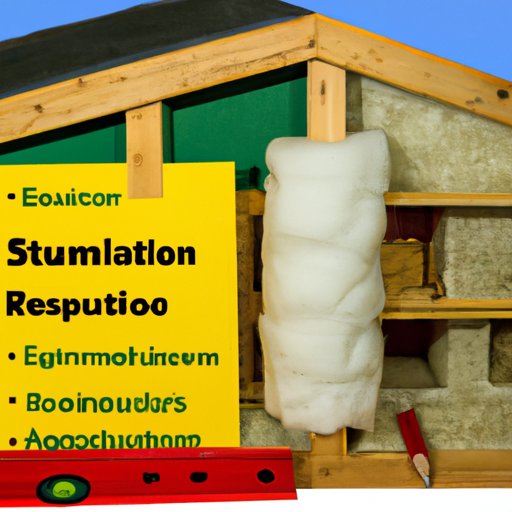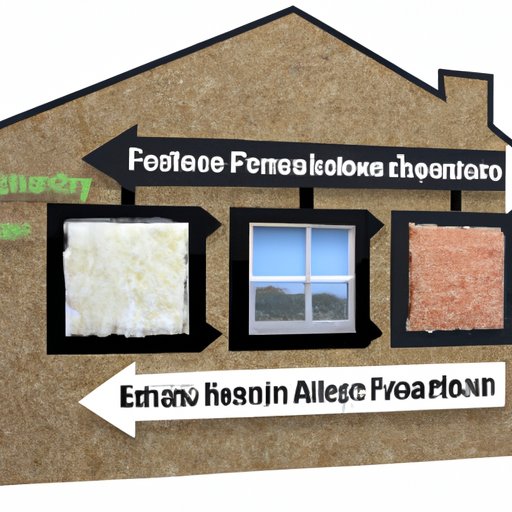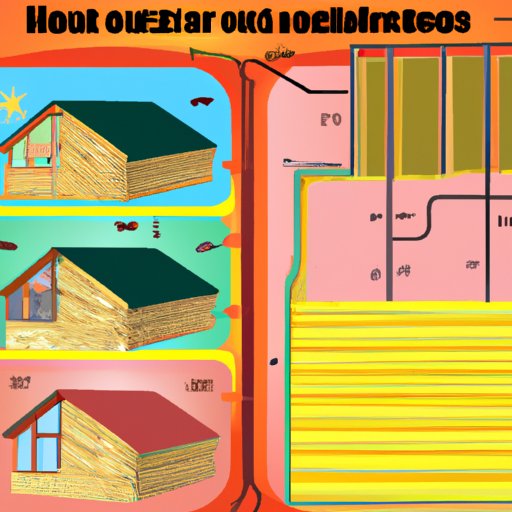Introduction
Insulation is a material that helps to reduce the flow of thermal energy, which is also known as heat. In the context of science, insulation is used to minimize the amount of heat transfer between two objects or areas. This can be done by blocking the path of heat transfer, such as air convection, conduction, and radiation. Insulation is an essential component of many structures and has a wide range of applications in both residential and commercial settings.
The purpose of this article is to explore the science of insulation in depth. We will discuss what insulation is and how it works, the different types of insulation and their properties, the different materials used for insulation, the pros and cons of using various types of insulation, a comprehensive guide to insulation in home construction, and a look at new insulation technologies and their impact on energy efficiency.
Exploring the Science of Insulation: What is it and How Does it Work?
In order to understand insulation, we must first understand thermal energy and heat transfer. Thermal energy is a form of energy that is created by the movement of particles, such as atoms and molecules. Heat transfer occurs when thermal energy is transferred from one object to another. This process can occur through three main mechanisms: conduction, convection, and radiation.
Conduction is the transfer of thermal energy through direct contact with the material. This type of heat transfer occurs when two objects are in contact with each other, such as when a hot pan is placed on a cold countertop. Convection is the transfer of thermal energy through the movement of liquids or gases. This type of heat transfer occurs when warm air rises and cool air falls. Radiation is the transfer of thermal energy through electromagnetic waves, such as infrared or ultraviolet light. This type of heat transfer occurs when the sun’s rays heats up the Earth’s surface.
Insulation is a material that works to reduce the amount of heat transfer between two objects or areas. This can be done by blocking the path of heat transfer, such as air convection, conduction, and radiation. By doing so, insulation helps to maintain a comfortable temperature in the environment and reduces energy costs by preventing heat loss.
The Different Types of Insulation and Their Benefits
There are a variety of different types of insulation that can be used in both residential and commercial settings. The most common types of insulation are fiberglass, cellulose, foam, rockwool, spray foam, and reflective foil. Each of these materials has their own unique properties and benefits.
Fiberglass is a popular type of insulation due to its affordability and ease of installation. It is made from glass fibers that are spun into a web-like structure and then coated with a plastic resin. Fiberglass is effective at reducing heat transfer and is fire resistant. However, it does not provide much sound insulation, and it can irritate skin and eyes if not handled properly.
Cellulose is made from recycled newspaper and other paper products and is treated with fire retardants and insect repellents. It is effective at reducing heat transfer and is also good at dampening sound. However, it is not as durable as other types of insulation.
Foam insulation is made from polyurethane and is sprayed onto walls and ceilings. It is very effective at reducing heat transfer and is also good at blocking sound. Foam insulation is more expensive than other types of insulation but is also more durable.
Rockwool is made from melted rocks, such as basalt and dolomite, and is spun into fibers. It is effective at reducing heat transfer and is also good at blocking sound. Rockwool is more expensive than other types of insulation, but it is also more durable and can last for decades.
Spray foam insulation is made from polyurethane and is sprayed onto walls and ceilings. It is extremely effective at reducing heat transfer and is also good at blocking sound. Spray foam insulation is more expensive than other types of insulation but is also more durable and can last for decades.
Reflective foil insulation is made from aluminum foil and is installed in walls and ceilings. It is effective at reflecting heat away from the area, which helps to reduce heat transfer. Reflective foil insulation is more expensive than other types of insulation but is also more durable and can last for decades.

A Comprehensive Guide to Insulation in Home Construction
When selecting insulation for your home, there are several factors to consider. First, you should determine what type of insulation is best suited for your needs. This will depend on the climate, the size and shape of your home, and your budget. You should also take into account the R-value of the insulation, which is a measure of its resistance to heat transfer.
Once you have selected the type of insulation you wish to use, you should then follow the proper steps for installing it. For fiberglass insulation, you should wear protective clothing and install it in either rolls or batts. For cellulose insulation, you should wear protective clothing, seal any gaps and cracks, and install it in either loose fill or batts. For foam insulation, you should wear protective clothing, seal any gaps and cracks, and install it in either sheets or panels. For rockwool insulation, you should wear protective clothing and install it in either batts or blankets. For spray foam insulation, you should wear protective clothing, seal any gaps and cracks, and install it in either sheets or panels. And for reflective foil insulation, you should wear protective clothing and install it in either rolls or sheets.

A Look at New Insulation Technologies and Their Impact on Energy Efficiency
New insulation technologies are continually being developed to help improve energy efficiency. These technologies allow for better control of heat transfer and can help reduce energy costs. Some of these technologies include vacuum insulated panels, aerogel insulation, and phase change materials.
Vacuum insulated panels (VIPs) are made from a thin layer of metal sandwiched between two layers of insulation. These panels are lightweight and highly effective at preventing heat transfer. Aerogel insulation is made from a gel-like substance and is extremely effective at blocking heat transfer. Phase change materials (PCMs) are made from waxes and oils that absorb and release energy as they transition between solid and liquid states.
In addition to these new insulation technologies, there are also government incentives available for utilizing energy-efficient insulation. These incentives can help offset the cost of installation and can result in significant savings over time.
Conclusion
Insulation is an essential component of many structures and has a wide range of applications in both residential and commercial settings. There are a variety of different types of insulation that can be used, each with their own unique properties and benefits. When selecting insulation for your home, there are several factors to consider, such as the type of insulation, the R-value, and the cost. Additionally, there are new insulation technologies that are continually being developed to help improve energy efficiency.
By understanding insulation and utilizing energy-efficient insulation technologies, you can help reduce energy costs and minimize the amount of heat transfer. Insulation is an important part of home construction and can have a significant impact on the comfort and energy efficiency of your home.
(Note: Is this article not meeting your expectations? Do you have knowledge or insights to share? Unlock new opportunities and expand your reach by joining our authors team. Click Registration to join us and share your expertise with our readers.)
